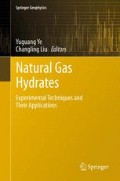Abstract
Natural gas hydrate synthesized in the porous medium is hardly observed by naked eyes, so indirect technique has to be employed to research the characteristics of hydrate and the relevant reactions. Electrical resistance detection is one of the most important methods to investigate the hydrates formation and dissociation processes. A lot of experiments have been done to clarify the relationship between the electrical resistance variation and hydrates thermodynamic or kinetics properties. In this chapter, three main aspects of electrical resistance application in hydrate experiments are discussed, including dividing different stages of hydrate formation or dissociation process reflected by electrical resistance variation, establishing hydrate nucleation theoretical model based on electrical resistance data, and the determination of hydrate saturation in porous-medium system.
Access this chapter
Tax calculation will be finalised at checkout
Purchases are for personal use only
References
Sloan ED. Clathrate hydrates of natural gases. 2nd ed. New York: Marcel Dekker Inc; 1998.
Buffett BA, Zatsepina OY. Formation of gas hydrate from dissolved gas in natural porous media. Mar Geol. 2000;164(1):69.
Zatsepina OY, Buffett BA. Nucleation of CO2−hydrate in a porous medium. Fluid Phase Equilib. 2002;200(2):263.
Liu Changling, Ye Yuguang, Zhang Jian, Diao Shaobo. Study on simulation experiments of marine gas hydrate. Rock Miner Anal. 2004;3.
Chen Qiang, Liu Changling, Ye Yuguang, Diao Shaobo, Zhang Jian. Preliminary research about the nucleation of gas hydrate in porous media. Acta Petrolei Sinica (Pet Process Sect). 2008;3.
Booth JS, Winters WJ, Dillon WP. Apparatus investigates geological aspects of gas hydrates. Oil Gas J. 1999;97(40):63–70.
Gu Yidong, Lin Weizheng, Zhang Jian, Ye Yuguang. Ultrasonic detecting technique for nature gas hydrates in sediment. Ocean Technol. 2005;24(3):46–52.
Wright JF, Nixon FM, Dallimore SR, et al. A method for direct measurement of gas hydrate amounts based on the bulk dielectric properties of laboratory test media[M]. In Proceedings of the fourth international conference on gas hydrates. Yokohama: Keio University, 2002. pp 745–749.
Ye Yuguang, Zhang Jian, Hu Gaowei, Diao Shaobo, Liu Changling. Combined detection technique of ultrasonic and time domain reflectometry in gas hydrate. Mar Geol Quat Geol. 2008;28(5):101–8.
Wu Qingbai, Pu Yibin, Jiang Guanli, et al. Experimental research of formation and dissociation processes of methane hydrate by computerized tomography. J Glaciol Geocryol. 2006;1.
Song Yongchen, Yang Mingjun, Liu Yu. Progress in the experimental detection technology of gas hydrate formation and dissociation. Nat Gas Ind. 2008;8.
Li Shuxia, Xia Xiran, Hao Yongmao, Li Qingping. Application of resistivity measurement in the system of sediment-brine-methane hydrate. J Exp Mech. 2010;25(1):95–9.
Zatsepina OY, Buffett BA. Experimental study of the stability of CO2 hydrate in a porous medium. Fluid Phase Equilib. 2001;192:85–102.
Zhou Xitang, Fan Shuanshi, Liang Deqing. Detecting formation and dissociation of NGH by measuring conductivity. Nat Gas Geosci. 2007;18(4):593–5.
Zhao Hongwei, Diao Shaobo, Ye Yuguang, et al. Technique of detecting impedance of hydrate in porous medium. Mar Geol Quat Geol. 2005;25(1):137–42.
Chen Qiang, Ye Yuguang, Meng Qingguo, et al. Simulation experiment of the relationship between CO2 hydrate saturation and resistance in porous media. Nat Gas Geosci. 2009;20(2).
Trebble MA, Bishnoi PR. Extension of the trebble-Bishnoi equation of state to mixtures. Fluid Phase Equilib. 1988;40:1–21.
Vander Waals JH, Platteeuw JC. Clathrate solutions. Adv. Chem. Phys. 1959; 2:1–57.
Sloan ED, Fleyfel F. A molecular mechanism for gas hydrate nucleation from ice. AIChEJ. 1991;37:1281–98.
Kashchiev D, Firoozabad A. Driving force for crystallization of gas hydrate. J Cryst Growth. 2002;241:220–30.
Christiansen RL, Sloan ED. Mechanisms and kinetics of hydrate formation. Ann NY Acad Sci. 1993;715:283–305.
Handa YP. Effect of hydrostatic pressure and salinity on the stability of gas hydrate. J Phys Chem. 1990;94:2652–7.
Kvenvolden KA. Worldwide distribution of subaquatic gas hydrates. Geomar Lett. 1993;13:32–40.
Wu Nengyou, Chen Hong, et al. Scientific ocean drilling and gas-hydrates. Adv Earth Sci. 2003;18(5):753–7.
Kvenolden KA. Potential effects of gas hydrate on human welfare. Proc Natl Acad Sci USA. 1999;95:3420–6.
Duofu C, Maochun W, et al. Formation condition and distribution prediction of gas hydrate in Qinghai-Tibet Plateau permafrost. Chin J Geophys. 2005;48(1):165–72.
Lu Zhenquan, Wu Bihao, et al. Preliminary discussion on origin and formation of potential gas hydrates in South China Sea. Miner Depos. 2002;21(3):232–9.
Lei Huaiyan, Wang Xianbin, et al. Current situation of gas hydrates research and challenges for future. Acta Sedimentologica Sinica. 1999;17(3):493–6.
Riedel M, Collett TS, Hyndman RD. Gas hydrate concentration estimates from chlorinity, electrical resistivity and seismic velocity. Geol Surv Can. 2005;4934:28–32.
Pearson CF, Halleck PM, McGuire PL, et al. Natural gas hydrate: a review of in situ properties. J Phys Chem. 1983;87:4180–5.
Nobes DC, Villinger H, Davis FF, et al. Estimation of marine sediment bulk physical properties at depth from seafloor geophysical measurements. J Geophys Res. 1986;91:14033–43.
Paull CK, Matsumoto R, Wallace PJ, et al. In: Proceedings of the Ocean Drilling Program, Initial Report 164. College Station: Ocean Drilling Program; 1996. p. 623.
Spangenberg E, Kulenkampff J. Physical properties of gas hydrate-bearing sediments. In: 5th International Conference on Gas Hydrate, Trondheim, Norway; 2005. p. 587−96.
Author information
Authors and Affiliations
Corresponding author
Editor information
Editors and Affiliations
Rights and permissions
Copyright information
© 2013 Springer-Verlag Berlin Heidelberg
About this chapter
Cite this chapter
Chen, Q., Diao, S., Ye, Y. (2013). Detecting Hydrate in Porous Media Using Electrical Resistance. In: Ye, Y., Liu, C. (eds) Natural Gas Hydrates. Springer Geophysics. Springer, Berlin, Heidelberg. https://doi.org/10.1007/978-3-642-31101-7_4
Download citation
DOI: https://doi.org/10.1007/978-3-642-31101-7_4
Published:
Publisher Name: Springer, Berlin, Heidelberg
Print ISBN: 978-3-642-31100-0
Online ISBN: 978-3-642-31101-7
eBook Packages: Earth and Environmental ScienceEarth and Environmental Science (R0)

